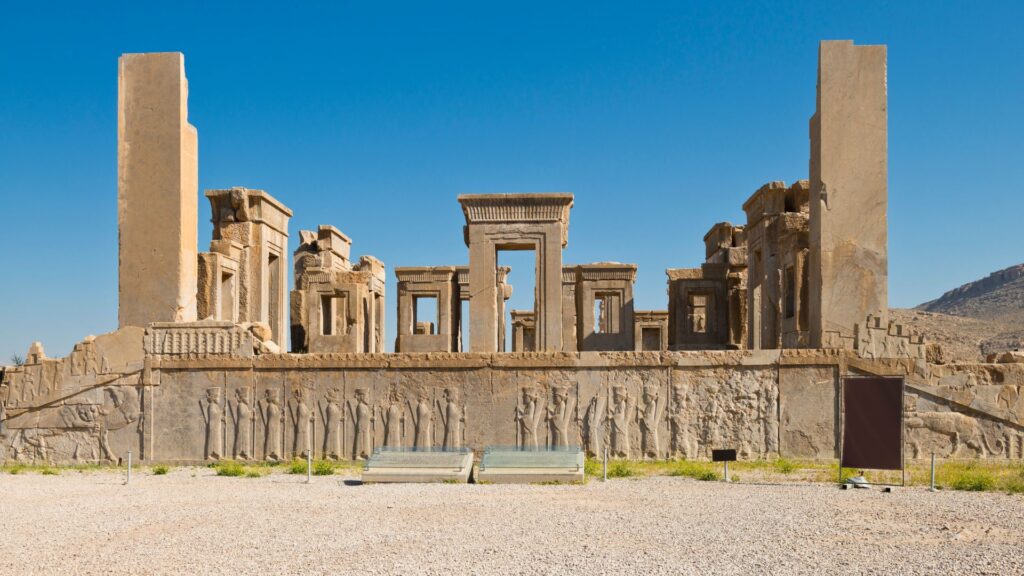
Ancient Era
Iran has been one of the primary centers for the extraction and use of building stones since ancient times. Early civilizations such as the Elamites, Achaemenids, Sassanids, and Seleucids used stone for constructing temples, palaces, bridges, and inscriptions.
- Achaemenid Era: Limestone, marble, and granite were used in structures like Persepolis and Pasargadae.
- Sassanid Era: The use of stone is evident in palaces such as Taq Kasra and the Palace of Bishapur.
- Islamic Era: During the Safavid and Qajar periods, the use of travertine and marble flourished in palaces and religious sites.
Modern Era (Before Iran's Industrial Revolution)
Until the early 20th century, stone extraction was primarily done manually and traditionally. Tools such as picks, chisels, and hammers were used to separate stone from mountains, and cutting was mostly done by hand using traditional methods.
- Cities like Isfahan, Hamadan, Yazd, Kerman, and Tabriz have long been the main centers of stone production.
- Marble, travertine, and granite were extracted from local mines and used in historical structures such as mosques, bridges, and caravanserais.
Industrialization Era (After 1340 Solar Hijri)
With the introduction of machinery and new technologies in the 1340s (1960s), Iran’s stone industry underwent a transformation.
- The use of stone cutting machines, wire saws, and polishing equipment began.
- Industrial stone production complexes, such as Mahmoudabad and Rizvanshahr, were established in Isfahan Province.
- The export of decorative stones to neighboring countries like Iraq and Kuwait commenced.
Post-Revolution Era and Industry Growth (1357 to Present)
After the Islamic Revolution, stone production in Iran expanded, and investments in mining and processing increased.
- 1370s (1990s): Development of mines and improvement in stone processing technologies.
- 1380s (2000s): Growth in stone exports to European countries, China, and the Persian Gulf region.
- 1390s (2010s): Increased production of travertine, marble, onyx, and granite.
- Today: Iran is one of the largest producers of building stones in the world and ranks among the top 5 stone-producing countries globally.
Current Status of the Stone Industry in Iran
Today, Iran has over 2,000 active stone mines and approximately 6,000 stone processing factories that produce and export various types of building stones.
Most Important Stones Produced in Iran
- Travertine: Mines in Mahallat, Azarshahr, and Takab.
- Marble: Mines in Dehbid, Chahgaz, and Harsin.
- Onyx (Crystal): Mines in Aligudarz, Neyriz, and Sirjan.
- Granite: Mines in Natanz, Zahedan, and Hamadan.
Most Important Stone-Producing Cities
- Isfahan (Najafabad, Rizvanshahr, Mahmoudabad) – The hub of stone processing in Iran.
- Tehran, Yazd, Lorestan, Fars, Hamadan, East Azerbaijan – Home to significant stone mines.
Iran's Position in the Global Stone Market
- Iran, with approximately 5 billion tons of building stone reserves, ranks as the fourth country in the world in terms of stone reserves.
- Iran exports stone to China, Italy, India, Turkey, and Arab countries.
- Despite its high potential, challenges such as raw material sales, lack of modern technologies, and sanctions have reduced the industry’s productivity.
Future Outlook
- Increasing production and adopting new technologies in stone processing.
- Reducing raw material sales and boosting exports of processed products.
- Investing in new mines and improving the quality of extraction and cutting.
Despite challenges, Iran has significant potential to become one of the global hubs of the stone industry.

